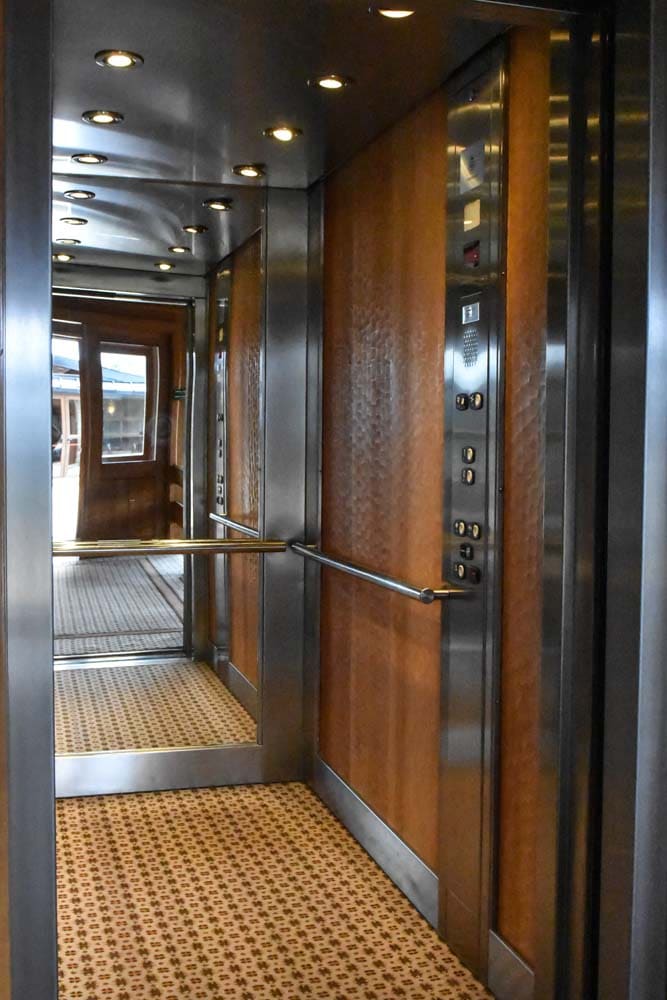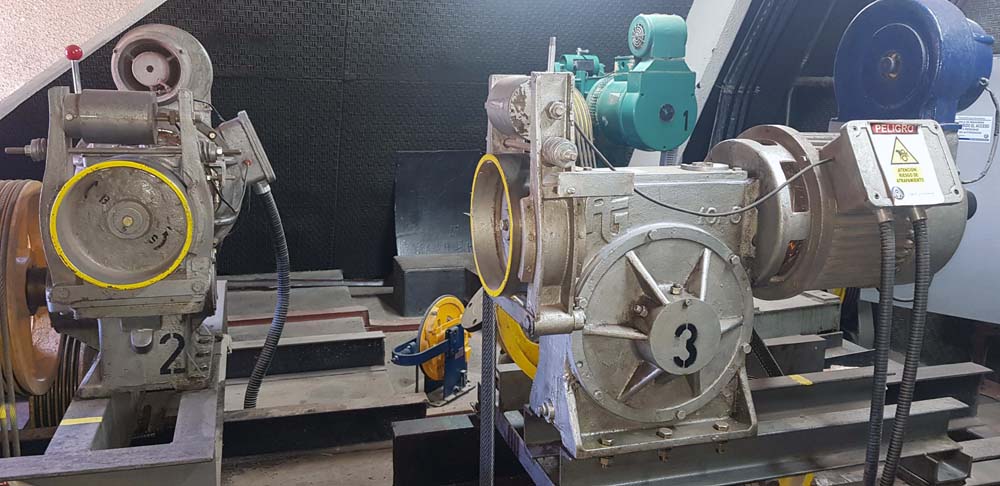A Story of Destruction and Rebirth
Dec 1, 2021

Iconic Llao Llao Hotel in Argentine Patagonia and its VT system continue to enchant.
photos courtesy of Ascensores Patagonia, Gustavo Marcovich and Andrea Pintos
Situated between two lakes, in the shadow of a 2,075-m-tall mountain, the Llao Llao Hotel in Argentine Patagonia was inspired by its stunning surroundings and named, ironically, for a parasitic tree fungus. More than 500,000 trees were harvested for its construction in 1936, having a significant environmental impact in an area that would, in years to come, earn a reputation for carefully landscaped green meadows. Aesthetically, the llao llao fungus is not unappealing, resembling the decorative balls that sit in bowls arranged by interior decorators. Despite its parasitic nature, it’s not harmful to trees, either. Affected native trees — ñires and coihues — grow galls (growths) to bypass sap blockages caused by the Llao Llao, and the fungus expands out of the galls to other parts of the tree. It then grows out of branches like a large fruit; in a sense, it is: “Llao llao is an edible mushroom with a sweetness prized for its uses in desserts such as ice cream,” describes one source.[1]
Born of Privilege
The emblematic hotel was built during the 1930s to promote tourism in San Carlos de Bariloche, a privileged area in Argentine Patagonia. It was closed starting in the late 1970s for nearly 15 years and reopened in 1993. The original Otis elevators were refurbished, and now, the Llao Llao Hotel is served by 15 operating units produced by various manufacturers.
The hotel is located in an imposing landscape: Moreno and Nahuel Huapi lakes at either side and the Cerro López mountain standing watch at its back. Surrounding parks were designed by German landscape architect Hermann Botrich. The Bustillo brothers were involved in the hotel’s founding. They were lawyer Exequiel, who was, at the time, the first president of the new Administración de Parques Nacionales (National Parks Agency), and Alejandro, a gifted architect.
When Ezequiel Bustillo visited San Carlos de Bariloche and nearby areas, he was fascinated by the landscape and the touristic possibilities of the region, so he deemed it necessary to build a hotel in a style that fit this background. The commission ended up in the hands of Alejandro Bustillo, who accepted it on one condition: He would not take a single cent for the job.
The hotel’s birth was strongly based on the political need to assert national sovereignty in Patagonia by creating urban centers based on the tourism potential of the virgin Andean zone. Construction began in 1936. Alejandro Bustillo built a magnificent structure in the Canadian style using cypress logs and larch roof tiles with balconies, terraces and windows boasting exceptional panoramic views.
Two Rebirths
On January 8, 1938, the hotel officially opened. Shortly afterward, in October 1939, the premises that dazzled visitors and were the pride of Bariloche were totally reduced to ashes in a fire. After the fire, the Bustillo brothers started rebuilding but, this time, used fireproof materials such as stone, concrete and brick. The hotel was reopened a little over a year later. During the first 10 years after reopening, the number of tourists who visited Nahuel Huapi National Park quadrupled. However, some decades later, as a result of bad policies and lack of investment, the Llao Llao was so abandoned that it closed in 1979, becoming a prime looting target.
In 1993, the hotel was reopened again and baptized Llao Llao Hotel & Resort under new ownership and management. Today, it is run by a private management firm and remains the most emblematic Patagonian hotel. The oldest pictures show wooden façades and window shutters, but now, reinforced concrete structures and outside walls replace wooden planks.
One of the most important modifications was the construction of a new wing, Ala Moreno, which opened in 2007. The addition added 43 rooms organized in six blocks on five levels, increasing capacity by 25% with a total of 205 rooms.
Elevator cabs feature wood or glass combined with lenga beech wood a characteristic tree of the Patagonian-Andean forest — with bronze details.
VT Over the Years
For the 1993 reopening, original vertical-transportation (VT) equipment, including Otis elevators, was refurbished by Ascensores Guillemi. The main ones were completely replaced with AC speed controllers that still work. At the time, the Otis machines were kept in the service elevators, but the controllers and electrical components were replaced. Over the years, Argentine-manufactured Adsur machines finally replaced the old Otis machines. Until 2007, there were only seven elevators, but later, new equipment was installed to meet accessibility requirements.
Present VT Installations
At present, 15 elevators running from two to six floors serve the hotel. There are eight passenger units, half traction and half hydraulic. TK Elevator (TKE) installed five elevators in the new Ala Moreno building and modernized some of the older units.
The machines are mostly TKE, but three others were furnished by Argentine companies Ascensores Guillemi and Adsur. Nearly all are operated by automatic controllers. They travel at 60 m/min. Their cabs feature wood or glass combined with lenga beech wood — a characteristic tree of the Patagonian-Andean forest — with bronze details. A traction heavy-duty elevator accesses the kitchen at 45 m/min. The four service elevators are also traction units, with cabs built of stainless steel that run at a speed of 60 m/min.
The hydraulic Italian systems were supplied by GMV and Omar Lift, and travel at 32 m/min. A hydraulic platform lift is also available for guests with disabilities.
Maintenance
Ascensores Patagonia maintains the Llao elevators. The company started its activities in Bariloche 20 years ago and has represented TKE since 2006. Javier Rodríguez, its manager, gained wide experience in Buenos Aires working at KONE and Ascensores Atlas, a Brazilian branch of the company at the time.
The company is responsible for the maintenance of Otis, Schindler and TKE VT installations at several hotels, supermarkets and the famous Bariloche Atomic Centre, an R&D center of the Argentine National Atomic Energy Commission. However, Llao Llao hotel personnel are trained to rescue passengers because Ascensores Patagonia mechanics must drive 25 km along mountain roads during emergencies. Preventive maintenance is carried out on Saturdays.
Despite its long history and the many high-end, luxurious Bariloche hotels, the Llao Llao Hotel & Resort is still an icon that identifies a beautiful Argentine region.
Special thanks to Llao Llao Hotel & Resort management and Ascensores Patagonia for providing information.











Reference
Get more of Elevator World. Sign up for our free e-newsletter.








